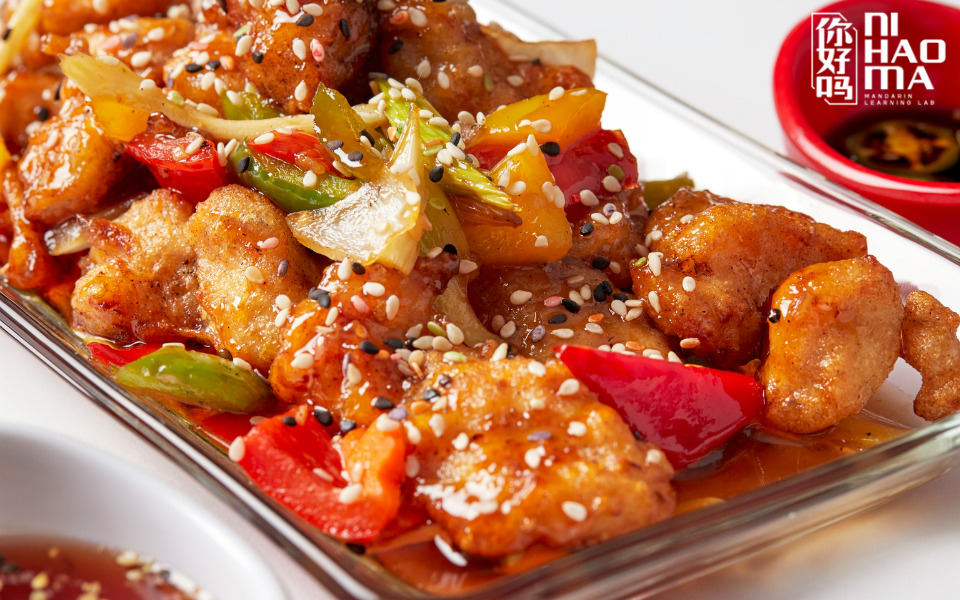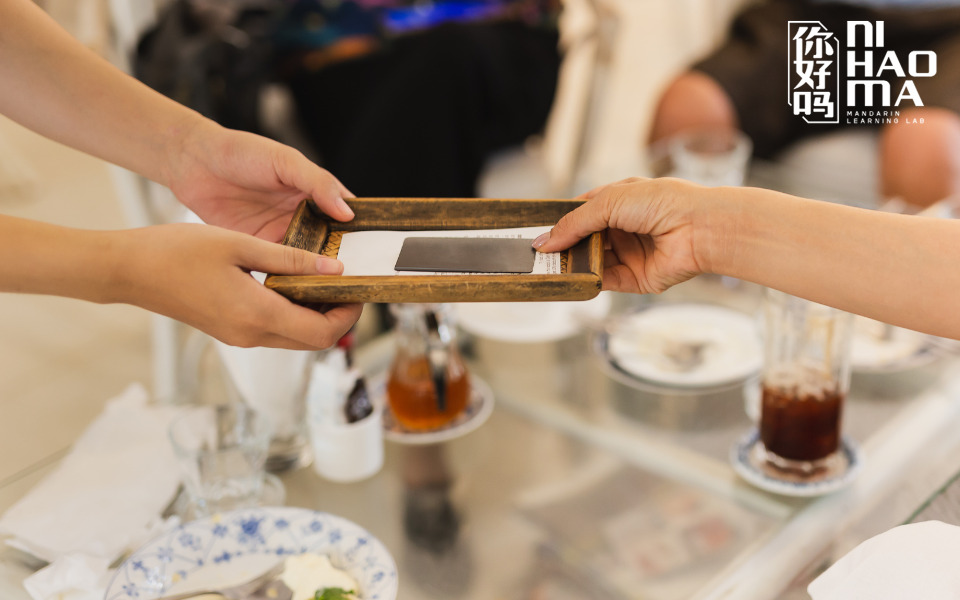Cuisine is an inseparable part of culture, and learning food vocabulary is a great way to get closer to the Chinese language and its people. In any situation, knowing food vocabulary in Chinese will help you communicate more confidently. Let’s explore the names of popular dishes in Chinese with Ni Hao Ma!
Food Vocabulary in Chinese: Famous Dishes Across China
Every region of China has its own unique specialty – from humble street food to intricate imperial banquets. If you’re a travel and language enthusiast, mastering Chinese food vocabulary about local specialties will be a “golden key” to fully experiencing authentic local cuisine.

| No. | Chinese Name | Pinyin | Meaning |
|---|---|---|---|
| 1 | 北京烤鸭 | Běijīng kǎoyā | Peking Duck |
| 2 | 火锅 | huǒguō | Hot Pot |
| 3 | 麻婆豆腐 | mápó dòufu | Mapo Tofu (Sichuan-style) |
| 4 | 小笼包 | xiǎolóngbāo | Soup Dumplings |
| 5 | 宫保鸡丁 | gōngbǎo jīdīng | Kung Pao Chicken |
| 6 | 鱼香肉丝 | yúxiāng ròusī | Fish-Flavored Shredded Pork |
| 7 | 红烧肉 | hóngshāoròu | Braised Pork Belly |
| 8 | 炸酱面 | zhájiàngmiàn | Noodles with Fried Bean Sauce |
| 9 | 担担面 | dàndànmiàn | Sichuan Spicy Noodles (Dan Dan) |
| 10 | 羊肉泡馍 | yángròu pàomó | Lamb Soup with Crumbled Flatbread |
| 11 | 叉烧 | chāshāo | Char Siu (Barbecued Pork) |
| 12 | 粽子 | zòngzi | Sticky Rice Dumplings |
| 13 | 饺子 | jiǎozi | Dumplings |
| 14 | 锅贴 | guōtiē | Pan-Fried Dumplings |
| 15 | 馒头 | mántou | Steamed Bun (Mantou) |
| 16 | 烧卖 | shāomài | Shaomai (Steamed Dumplings) |
| 17 | 虾饺 | xiājiǎo | Shrimp Dumplings (Har Gow) |
| 18 | 热干面 | règānmiàn | Wuhan Dry Noodles |
| 19 | 芝麻球 | zhīmaqiú | Sesame Balls |
| 20 | 月饼 | yuèbǐng | Mooncake |
| 21 | 桂花糕 | guìhuāgāo | Osmanthus Cake |
| 22 | 凉皮 | liángpí | Cold Skin Noodles |
| 23 | 油条 | yóutiáo | Fried Dough Sticks (Youtiao) |
| 24 | 豆腐脑 | dòufunǎo | Tofu Pudding (Douhua) |
| 25 | 酸辣汤 | suānlàtāng | Hot and Sour Soup (Sichuan-style) |
| 26 | 西湖牛肉羹 | Xīhú niúròu gēng | West Lake Beef Soup |
| 27 | 佛跳墙 | fótiàoqiáng | Buddha Jumps Over the Wall |
| 28 | 皮蛋瘦肉粥 | pídàn shòuròu zhōu | Century Egg and Pork Congee |
| 29 | 桂林米粉 | guìlín mǐfěn | Guilin Rice Noodles |
| 30 | 螺蛳粉 | luósīfěn | Snail Rice Noodles |
| 31 | 过桥米线 | guòqiáo mǐxiàn | Crossing-the-Bridge Noodles |
| 32 | 刀削面 | dāoxiāo miàn | Knife-Cut Noodles |
| 33 | 云吞 | yúntūn | Wonton |
| 34 | 炒面 | chǎomiàn | Stir-Fried Noodles |
| 35 | 煲仔饭 | bāozǎifàn | Claypot Rice |
| 36 | 酸辣粉 | suānlàfěn | Hot and Sour Glass Noodles |
| 37 | 粉蒸肉 | fěnzhēngròu | Steamed Pork with Rice Flour |
| 38 | 东坡肉 | Dōngpō ròu | Dongpo Pork |
| 39 | 松鼠鳜鱼 | Sōngshǔ guìyú | Squirrel-Shaped Mandarin Fish |
| 40 | 鱼香茄子 | yúxiāng qiézi | Fish-Flavored Eggplant |
| 41 | 饵块 | ěrkuài | Yunnan Rice Cakes |
| 42 | 地三鲜 | dìsānxiān | Three Earthly Treasures (Stir-Fry Veg) |
| 43 | 毛豆腐 | máo dòufu | Hairy Tofu |
| 44 | 片儿川 | piànrchuān | Pian Er Chuan Noodles (Hangzhou Style) |
| 45 | 盐水鸭 | yánshuǐ yā | Nanjing Salted Duck |
| 46 | 咕咾肉 | gūlǎoròu | Sweet and Sour Pork |
| 47 | 驴肉火烧 | lǘròu huǒshāo | Donkey Meat Sandwich |
| 48 | 驴打滚 | lǘdǎgǔn | Glutinous Rice Roll with Bean Flour |
| 49 | 汽锅鸡 | qìguō jī | Steamed Chicken in Clay Pot |
| 50 | 臭豆腐 | chòu dòufu | Stinky Tofu |
Daily Food Vocabulary in Chinese
Cuisine is not only a part of culture but also a bridge between languages. When learning Chinese, mastering vocabulary related to daily food helps you communicate more naturally in everyday situations—especially if you’re living, studying, or working with Chinese people.

In addition to the signature Chinese dishes listed above, this section by Ni Hao Ma will help you learn how to name foods in Chinese used in daily contexts (including Vietnamese dishes):
| No. | Chinese | Pinyin | Meaning |
|---|---|---|---|
| 1 | 米饭 | mǐfàn | White rice |
| 2 | 炒饭 | chǎofàn | Fried rice |
| 3 | 稀饭 | xīfàn | Thin porridge (watery) |
| 4 | 粥 | zhōu | Porridge |
| 5 | 面条 | miàntiáo | Noodles |
| 6 | 米粉 | mǐfěn | Rice vermicelli |
| 7 | 炒米粉 | chǎo mǐfěn | Stir-fried rice vermicelli |
| 8 | 河粉 | héfěn | Flat rice noodles (Hu tieu) |
| 9 | 越南卷粉 | Yuènán juǎnfěn | Vietnamese steamed rice rolls (Banh cuon) |
| 10 | 顺化牛肉粉 | shùn huà niúròu fěn | Huế beef noodle soup (Bun bo Hue) |
| 11 | 包子 | bāozi | Steamed bun |
| 12 | 蟹湯米線 | xiè tāng mǐ xiàn | Crab noodle soup (Bun rieu) |
| 13 | 鱼糕 | yú gāo | Fish cake |
| 14 | 冰淇淋 | bīngqílín | Ice cream |
| 15 | 芝士 | zhīshì | Cheese |
| 16 | 零食 | língshí | Snacks |
| 17 | 魚露米線 | yú lù mǐ xiàn | Fermented fish noodle soup (Bun mam) |
| 18 | 冰沙 | bīngshā | Smoothie |
| 19 | 咖喱鸡 | gālí jī | Chicken curry |
| 20 | 牛肉 | niúròu | Beef |
| 21 | 鸡肉 | jīròu | Chicken |
| 22 | 猪肉 | zhūròu | Pork |
| 23 | 薯条 | shǔtiáo | French fries |
| 24 | 汉堡包 | hànbǎobāo | Hamburger |
| 25 | 沙拉 | shālā | Salad |
| 26 | 方便面 | fāngbiànmiàn | Instant noodles |
| 27 | 豆腐 | dòufu | Tofu |
| 28 | 酸奶 | suānnǎi | Yogurt |
| 29 | 越南煎饼 | Yuènán jiānbing | Vietnamese sizzling pancake (Banh xeo) |
| 30 | 烤肉米粉 | kǎoròu mǐfěn | Grilled pork with vermicelli (Bun cha) |
| 31 | 粽子 | zòngzi | Sticky rice cake (Banh chung/banh tet) |
| 32 | 春卷 | chūnjuǎn | Fried spring roll |
| 33 | 越南酸肉 | Yuènán suānròu | Fermented pork (Nem chua) |
| 34 | 糯米饭 | nuòmǐ fàn | Sticky rice |
| 35 | 烤鸡 | kǎo jī | Grilled chicken |
| 36 | 烤肉 | kǎoròu | Grilled meat |
| 37 | 炸鱼 | zhá yú | Fried fish |
| 38 | 鴨肉筍湯粉 | Yā ròu sǔn tāng fěn | Duck bamboo noodle soup (Bun mang vit) |
| 39 | 烤肉粉 | kǎoròu fěn | Grilled meat with noodles (Bun thit nuong) |
| 40 | 虾酱豆腐米线 | xiā jiàng dòufu mǐxiàn | Tofu noodle with shrimp paste (Bun dau mam tom) |
| 41 | 鲜牛奶 | Xiān niúnǎi | Fresh milk |
| 42 | 凉拌 | Liángbàn | Mixed salad (Goi/Nom) |
| 43 | 广南面 | Guǎngnán miàn | Quảng-style noodles (Mi Quang) |
| 44 | 越南河粉 | Yuènán héfěn | Pho |
| 45 | 蛋糕 | dàngāo | Cake |
| 46 | 面包 | miànbāo | Bread |
| 47 | 三明治 | sānmíngzhì | Sandwich |
| 48 | 汤圆 | tāngyuán | Sweet rice balls (Che troi nuoc) |
| 49 | 黑豆沙 | hēidòu shā | Black bean sweet soup |
| 50 | 绿豆沙 | lǜdòu shā | Mung bean sweet soup |
| 51 | 千层糕 | qiāncéng gāo | Layered cake (Bánh da lợn) |
| 52 | 海绵蛋糕 | hǎimián dàngāo | Sponge cake |
| 53 | 水煮蛋 | shuǐzhǔ dàn | Boiled egg |
| 54 | 荷包蛋 | hébāo dàn | Fried egg (Sunny side up) |
| 55 | 蒸蛋 | zhēng dàn | Steamed egg |
| 56 | 汤 | tāng | Soup |
| 57 | 腊肠 | làcháng | Chinese sausage |
| 58 | 及第粥 | jídì zhōu | Offal porridge |
| 59 | 肉团 | ròutuán | Pork meatloaf |
| 60 | 炙肉 | zhì ròu | Grilled pork roll |
| 61 | 炸鸡 | zhájī | Fried chicken |
| 62 | 碎米饭 | suìmǐ fàn | Broken rice (Com tam) |
| 63 | 高楼面 | gāolóu miàn | Cao lau |
| 64 | 越式蝦捲 | Yuè shì xiā juǎn | Vietnamese spring rolls |
| 65 | 烤肉串 | kǎoròu chuàn | Grilled meat skewer |
Useful Chinese Phrases for Eating Out
With the Chinese food-related vocabulary above, you can now talk about food more fluently in Chinese. To help you communicate more naturally, Ni Hao Ma will introduce some commonly used phrases that you can use during meals in Chinese.
Conversation Before Ordering Food
When dining out, people often talk about various topics to create a comfortable atmosphere before officially ordering. For example, you can ask about the preferences of your dining companions to choose suitable dishes and learn more about their eating habits:
| Chinese | Pinyin | Meaning |
|---|---|---|
| 大家想吃点什么? | Dàjiā xiǎng chī diǎn shénme? | What would everyone like to eat? |
| 你喜欢吃什么? | Nǐ xǐhuan chī shénme? | What do you like to eat? |
| 你有什么忌口的吗? | Nǐ yǒu shénme jìkǒu de ma? | Do you avoid any food? |
| 你吃辣吗? | Nǐ chī là ma? | Do you eat spicy food? |
| 我不吃辣。 | Wǒ bù chī là. | I don’t eat spicy food. |
| 你吃素吗? | Nǐ chī sù ma? | Are you vegetarian? |
| 我对海鲜过敏。 | Wǒ duì hǎixiān guòmǐn. | I’m allergic to seafood. |
| 我们试试这家店的特色菜吧? | Wǒmen shì shì zhè jiā diàn de tèsè cài ba? | Shall we try this restaurant’s specialty dishes? |
| 这个怎么样? | Zhège zěnme yàng? | How about this dish? |
| 这个菜看起来不错。 | Zhège cài kàn qǐlái bùcuò. | This dish looks pretty good. |
How to Order Food in Chinese
Once you’ve decided on the dishes, you can start ordering. The following phrases will help you order politely and clearly:
| Chinese | Pinyin | Meaning |
|---|---|---|
| 请给我菜单。 | Qǐng gěi wǒ càidān. | Please give me the menu. |
| 请问这是什么菜? | Qǐngwèn zhè shì shénme cài? | Excuse me, what dish is this? |
| 我要一份… | Wǒ yào yī fèn… | I’d like one portion of… |
| 我要点菜。 | Wǒ yào diǎncài. | I want to order food. |
| 给我来一个这个。 | Gěi wǒ lái yī ge zhège. | I’ll have this dish. |
| 你推荐什么菜? | Nǐ tuījiàn shénme cài? | What dishes do you recommend? |
| 这个菜辣吗? | Zhège cài là ma? | Is this dish spicy? |
| 不要加… | Bùyào jiā… | Don’t add… (special request) |
| 多一点… | Duō yī diǎn… | A little more… (special request) |
| 就这些了,谢谢。 | Jiù zhèxiē le, xièxie. | That’s all, thank you. |

Common Dining Conversation Phrases
During the meal, you might want to express your opinions about the food or ask for more items in a natural way while enjoying the dishes.
| Chinese | Pinyin | Meaning |
|---|---|---|
| 这个很好吃。 | Zhège hěn hǎo chī. | This is delicious. |
| 味道不错。 | Wèidào búcuò. | It tastes good. |
| 太辣了。 | Tài là le. | It’s too spicy! |
| 可以给我筷子吗? | Kěyǐ gěi wǒ kuàizi ma? | Can I have some chopsticks? |
| 看起来真不错。 | Kàn qǐlái zhēn bùcuò. | It looks really good. |
| 这个菜有点淡。 | Zhège cài yǒudiǎn dàn. | This dish is a bit bland. |
| 这个菜好像不是我们点的。 | Zhège cài hǎoxiàng bù shì wǒmen diǎn de. | This doesn’t seem to be what we ordered. |
| 我们的菜还要多久? | Wǒmen de cài hái yào duōjiǔ? | How much longer for our food? |
| 再来一碗饭。 | Zài lái yì wǎn fàn. | Another bowl of rice, please. |
| 请给我一些辣椒酱。 | Qǐng gěi wǒ yīxiē làjiāo jiàng. | Please give me some chili sauce. |

Phrases for Paying the Bill in Chinese
After finishing your meal, you’ll need to ask for the bill, inquire about the price, or discuss splitting the cost. Here are some common phrases used when paying in a restaurant or eatery:
| Chinese | Pinyin | Meaning |
|---|---|---|
| 买单! | Mǎidān! | Check, please! |
| 我们要结账。 | Wǒmen yào jiézhàng. | We’d like to pay the bill. |
| 一共多少钱? | Yígòng duōshao qián? | How much is it in total? |
| 可以刷卡吗? | Kěyǐ shuākǎ ma? | Can I pay by card? |
| 我请客。 | Wǒ qǐngkè. | It’s my treat. |
| 这个菜我们没有点。 | Zhège cài wǒmen méiyǒu diǎn. | We didn’t order this dish. |
| 可以用支付宝/微信支付吗? | Kěyǐ yòng Zhīfùbǎo/Wēixìn zhīfù ma? | Can I pay with Alipay/WeChat Pay? |
| 不用找了。 | Bùyòng zhǎo le. | Keep the change. |
| 可以开发票吗? | Kěyǐ kāi fāpiào ma? | Can you issue an official receipt (fapiao)? |

Sample Dialogue Using Food Vocabulary in Chinese
Here’s a short conversation that shows how to use the vocabulary and phrases in a real dining situation:
A: 我们点菜吧。你想吃什么?
(Let’s order. What would you like to eat?)
B: 我不吃辣,能点个不辣的吗?
(I don’t eat spicy food. Can we order something mild?)
A: 好的,那我们点个清蒸鱼和青菜吧。
(Okay, let’s get steamed fish and vegetables.)
B: 可以,再加一个鸡蛋汤吧。
(Sure, and let’s add an egg soup.)
A: 好。服务员,点菜!
(Alright. Waiter, we’re ready to order!)

C: 好的,请问你们要点什么?
(Sure, what would you like to order?)
A: 我们要一个清蒸鱼,一份炒空心菜,还有一个鸡蛋汤。
(We’ll have one steamed fish, one stir-fried water spinach, and one egg soup.)
C: 好的,请稍等。
(Okay, please wait a moment.)
Conclusion
We hope this guide from Ni Hao Ma has added valuable Chinese food vocabulary to your communication toolkit. By mastering these words and phrases, you’ll feel more confident when traveling, dining, or interacting with native speakers. Keep practicing and using them in real life to retain them better!



